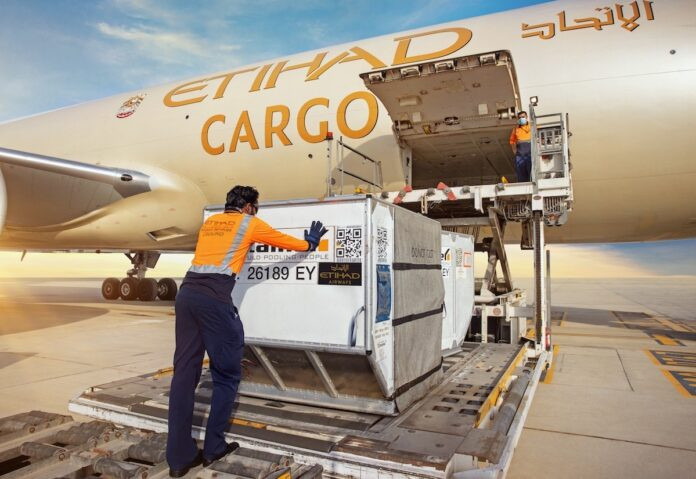

With travel effectively back to pre-pandemic levels globally, airports have shifted their focus back to passenger operations, putting a squeeze on freighter-only operations. As the industry settles into its next chapter, the winners seem to be those who can combine both passenger and cargo operations to ensure connectivity in key destinations, guaranteeing coverage into the future.
This is the mindset that underpins Etihad Cargo’s operations, recognising how belly capacity provides a high quality option directly into cities that aren’t traditionally served by freighters or would otherwise be limited without passenger travel.
“Belly capacity always comes with more frequency, providing a reliable schedule and efficient connections, helping high yielding cargo, such as express or pharmaceuticals,” Leonard Rodrigues, head of revenue management and network planning at Etihad Cargo, highlighted. “Benefitting from 70% of your capacity being done through bellyhold capacity is always a blessing.”
READ: Collaboration to grow the cool chain
Gaining momentum
The overall trajectory of Etihad Cargo’s performance throughout 2023 followed a pattern similar to that experienced by many. Factors such as a stable but insufficient supply due to the ongoing absence of Chinese passengers, combined with geopolitical challenges in Russia, contributed to a persistently low supply level.
While uncertainties loom over 2024, the market has shown resilience, adapting to various phases from a global drop in volumes to a period of intense price competition, followed by a resurgence driven by e-commerce demand.
Addressing these capacity requirements in areas of high demand is crucial. For instance, recognising variations in demand, such as weaker demand in China compared to stronger demand in other regions.
Etihad’s approach of combining cargo and passenger operations has seen the carrier launch into an ambitious flight path looking forward. Adding destinations on a regular basis is set to generate a projected compound annual growth rate of 30% on the passenger side over the next seven years. This will correlate to a 3% annual increase in the number of travellers on the airline each year, delivering 10% more capacity per year on the cargo side.
“It’s great because it’s ambitious. It helps us fly to more places and new places with better frequency. At the same time, it’s not overheating our capacity to grow,” Rodrigues explained. “Even though the plan is ambitious, on the passenger and cargo side, the growth is quite controllable.”
The growing global network offers an opportunity to tap into a diverse range of segments but there’s one sector where Etihad Cargo is keen to capitalise on: the cool chain.
Aligning their vision with efforts from the United Arab Emirates (UAE) to become a hub for life sciences and pharmaceutical goods, Etihad has put investment into their infrastructure, with a new pharma centre and seasonal strategies to protect movements during the hottest months.
“From a temperature perspective, we’ve shifted operations. We’ve ordered cool dollies to reinforce ramp exposure. We’re learning everything we can do with the new terminal before the summer comes, so this is the number one investment for us,” Rodrigues stated.
READ: Etihad Cargo attains IATA CEIV Lithium Batteries Certification
Asian potential
Despite the weak demand that was seen in China through 2023, it is clear that it still presents strong potential as the world’s leading market.
With the global trend of companies adopting a “China plus one” approach for production relocation in the fallout of the Covid pandemic, Etihad Cargo is looking to increase freighter capacity in China, and surrounding regions.
Notably, there is a discernible demand for contracts out of China and Vietnam, but India has yet to show a significant increase. The “China plus one” strategy may eventually include India, but these strategic shifts often take a few years to materialise.
There are three key components in the Asia-Pacific region that warrant attention: traditional shipments, e-commerce players, and the supply dynamics.
Traditional shipments, originating from various locations, currently exhibit relatively low demand compared to pre-COVID levels. However, the inventory-to-sales ratio indicates depleting inventories, signalling a potential shift from a deflationary phase to an inflationary one.
“It’s key to monitor this because, potentially, some verticals, like garments, will not come up as strong as others and then some markets might grow faster than others,” Rodrigues explained.
The second critical component is the booming e-commerce sector. While major players project significant growth, questions remain about how long it will boost the airfreight industry.
“There’s a fair amount of risk in the amount of growth that players project from e-commerce, so there’s a question around the sustainability of the demand from this segment, so this is going to affect the overall strategy in China,” Rodrigues continued.
The third element on supply will continue through 2024, as inflationary issues and traveller numbers become clearer. Looking ahead on this, the focus will on strategic forecasting for the next six months, allowing time to adapt to evolving market needs.
“If there is a reactive situation in a region, we’re ready for a swift response with the flexibility of our network,” Rodrigues said.










